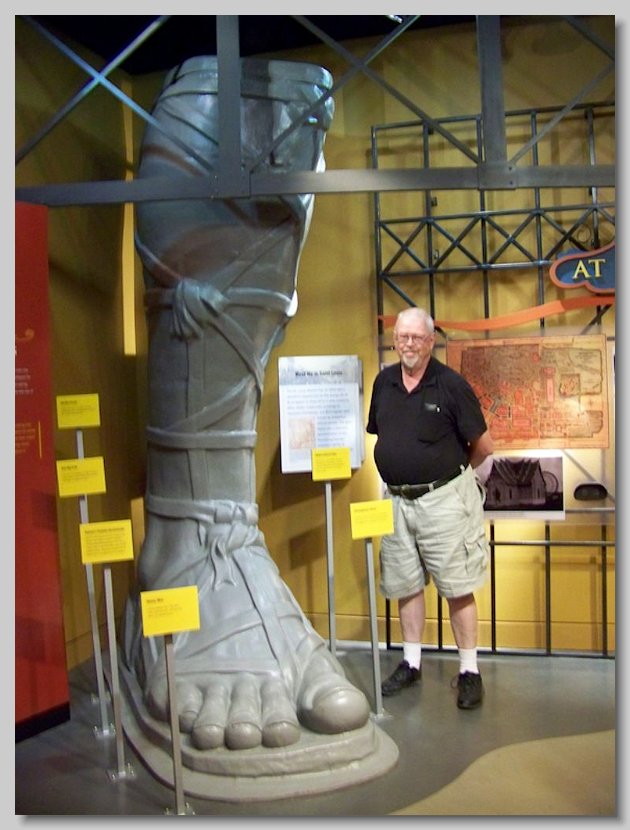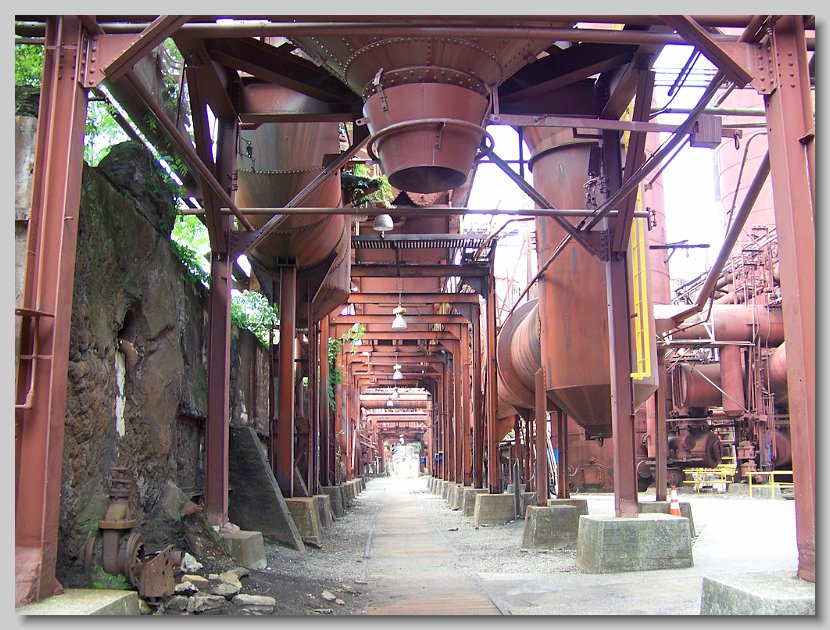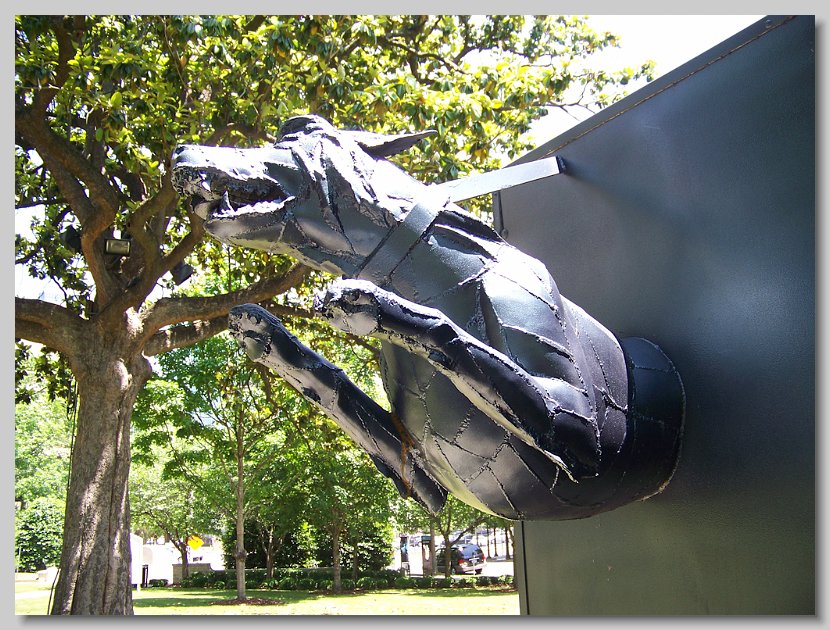
May 5-10 - Alabama Part 2
 We toured Alabama generally from South to North. Here's part 2 of our report . . . We toured Alabama generally from South to North. Here's part 2 of our report . . .
From Montgomery, it was just 78 miles to Birmingham (17), Alabama's largest city, where we stopped for 3 nights. Birmingham is a city created in the late 1800s as an industrial city. It became the "Pittsburgh of the South" because of the many iron furnaces. Local supplies of everything need to make iron - ore, limestone and coal - were met by the railroads. Energetic industrialists put up the money, and the city happened almost overnight. Today, the furnaces are silent, and the industry is more modern, and the city appears to be thriving.
 We spent a couple of hours visiting Vulcan. Nothing to do with Mr Spock, it's a huge statue of Vulcan, the Roman god of fire and the forge. It's the largest cast-iron statue in the world (56 ft), created for a city exhibit at the 1904 St Louis World's Fair. Today it stands atop one of the highest hills in Birmingham, surveying the city created by iron. The museum nearby tells the story of the iron industry in Birmingham and the people who made it work - both the industrialists who owned it and the workers who did the dirty stuff. Fun fact: When the proposal was first floated to place the statue up on that hill for everyone to see, there was lots of discussion about the "appropriateness" of prominently displaying a statue of a semi-clothed man - Vulcan was wearing an apron, but no pants. Today, you can buy a genuine Vulcan bobble-head doll in the museum gift shop. In a backhanded tribute to that 1930's angst, the bobble-head doll also has a bobble-butt. Cheeky, what? We spent a couple of hours visiting Vulcan. Nothing to do with Mr Spock, it's a huge statue of Vulcan, the Roman god of fire and the forge. It's the largest cast-iron statue in the world (56 ft), created for a city exhibit at the 1904 St Louis World's Fair. Today it stands atop one of the highest hills in Birmingham, surveying the city created by iron. The museum nearby tells the story of the iron industry in Birmingham and the people who made it work - both the industrialists who owned it and the workers who did the dirty stuff. Fun fact: When the proposal was first floated to place the statue up on that hill for everyone to see, there was lots of discussion about the "appropriateness" of prominently displaying a statue of a semi-clothed man - Vulcan was wearing an apron, but no pants. Today, you can buy a genuine Vulcan bobble-head doll in the museum gift shop. In a backhanded tribute to that 1930's angst, the bobble-head doll also has a bobble-butt. Cheeky, what?
 We visited the Sloss Iron Furnaces, now a city park, once one of the major iron furnace operations, in use until the early 1970s. You can get up close to the massive equipment used, and get a better understanding of how a blast furnace works. It's fascinating to try to imagine how somebody figured out that if you dump iron ore, coal and limestone into the top of a big container and then blow really hot air into it, you'll get iron out of the bottom. It was almost a perpetual motion machine - the compressors and ovens that heated the air were fueled by waste gases from the furnaces. We visited the Sloss Iron Furnaces, now a city park, once one of the major iron furnace operations, in use until the early 1970s. You can get up close to the massive equipment used, and get a better understanding of how a blast furnace works. It's fascinating to try to imagine how somebody figured out that if you dump iron ore, coal and limestone into the top of a big container and then blow really hot air into it, you'll get iron out of the bottom. It was almost a perpetual motion machine - the compressors and ovens that heated the air were fueled by waste gases from the furnaces.
We toured the best of Birmingham's antebellum mansions, Arlington, where we learned a bit more of the history of the area, and where Judy got to play a really old pump organ, much to the delight of our tour guide. Neat place.
We've kind of become addicted to the food at the Texas Roadhouse chain of restaurants, and we tend to eat at them way too often. Judy says they have the best fried catfish anywhere. But the Texas Roadhouse in Pelham AL has to be the friendliest one yet. Because we'd never been to that restaurant, our server brought us a free appetizer - the addictive Baby Blossom fried onion creation. The manager then came by with a free sample of their ribs. And more dinner rolls. We left with four take-home boxes, filled with catfish, steak, french fries, baked beans, bread, honey butter, and salad. We lived on those leftovers three days. Maybe they're just naturally welcoming folks. Maybe they thought we were the folks from the AAA tour book. We don't really care.
 Our must-see stop in Birmingham was the Birmingham Civil Rights Institute Museum, an enlightening and sobering immersion into the Civil Rights struggles of the 50's and 60's. The museum illustrates how the segregated society functioned in the south, and the painful events that ultimately led to the end of a state-mandated segregation system. It's hard to realize that almost all of this happened during our lifetimes, and that we were pretty much geographically isolated from it all. Birmingham became a city after slavery was ended, but those who founded the city were determined to try to perpetuate it to the extent they could. We stood outside the 16th Street Baptist Church where the bomb killed those four young girls in 1963. We walked through Kelly Ingram Park, where many Civil Rights rallies were held, and where many marches began. The park today is peaceful, but sculptures of snarling police dogs and fire hose cannons are graphic reminders of the past. While we were in the museum, several school groups toured. It was interesting to see the reactions of the kids to some of the exhibits. Many were clearly moved. We certainly were. Our must-see stop in Birmingham was the Birmingham Civil Rights Institute Museum, an enlightening and sobering immersion into the Civil Rights struggles of the 50's and 60's. The museum illustrates how the segregated society functioned in the south, and the painful events that ultimately led to the end of a state-mandated segregation system. It's hard to realize that almost all of this happened during our lifetimes, and that we were pretty much geographically isolated from it all. Birmingham became a city after slavery was ended, but those who founded the city were determined to try to perpetuate it to the extent they could. We stood outside the 16th Street Baptist Church where the bomb killed those four young girls in 1963. We walked through Kelly Ingram Park, where many Civil Rights rallies were held, and where many marches began. The park today is peaceful, but sculptures of snarling police dogs and fire hose cannons are graphic reminders of the past. While we were in the museum, several school groups toured. It was interesting to see the reactions of the kids to some of the exhibits. Many were clearly moved. We certainly were.
 Our final Alabama stop was Huntsville (18), up near the Tennessee border. We spent just 2 nights, having come specifically to tour the US Space and Rocket Center. When the US was developing rockets after WW2, it was to Huntsville they brought those 118 German rocket scientists, headed by Wernher Von Braun. It was at the Army's Redstone Arsenal and subsequently at NASA's Marshall Spaceflight Center that almost all of the research and development for the US space program was done. The museums of the Space and Rocket Center have some very nice souvenirs left over from those efforts. A full-size Saturn rocket with an Apollo capsule up top is very impressive. A full-size space shuttle attached to the rockets and external fuel tanks is awesome. The trinkets and hardware and rockets and missiles scattered about the grounds are fascinating. We've now been to six of the ten NASA facilities in the US, and every one has shown us something we'd never seen before. Our final Alabama stop was Huntsville (18), up near the Tennessee border. We spent just 2 nights, having come specifically to tour the US Space and Rocket Center. When the US was developing rockets after WW2, it was to Huntsville they brought those 118 German rocket scientists, headed by Wernher Von Braun. It was at the Army's Redstone Arsenal and subsequently at NASA's Marshall Spaceflight Center that almost all of the research and development for the US space program was done. The museums of the Space and Rocket Center have some very nice souvenirs left over from those efforts. A full-size Saturn rocket with an Apollo capsule up top is very impressive. A full-size space shuttle attached to the rockets and external fuel tanks is awesome. The trinkets and hardware and rockets and missiles scattered about the grounds are fascinating. We've now been to six of the ten NASA facilities in the US, and every one has shown us something we'd never seen before.
 Unlike Birmingham, which created itself with a specific purpose, Huntsville reinvented itself when the racketeers came to town. Once a cotton-mill town, it's now a cosmopolitan city with (we heard) the highest per-capita number of PhD's in the country. We saw a stereotypical absent-minded-professor-looking guy getting into his car with the license plate "ROKTSCI". All that rocket stuff brought lots of the space industry's major players to Huntsville, and you see their names on lots of civic improvements. We spend a delightful few hours at the Huntsville Botanical Gardens, quite possibly the nicest gardens we've visited. More pictures of plant life. Unlike Birmingham, which created itself with a specific purpose, Huntsville reinvented itself when the racketeers came to town. Once a cotton-mill town, it's now a cosmopolitan city with (we heard) the highest per-capita number of PhD's in the country. We saw a stereotypical absent-minded-professor-looking guy getting into his car with the license plate "ROKTSCI". All that rocket stuff brought lots of the space industry's major players to Huntsville, and you see their names on lots of civic improvements. We spend a delightful few hours at the Huntsville Botanical Gardens, quite possibly the nicest gardens we've visited. More pictures of plant life.
Alabama's an interesting, complex state. The people are universally friendly and outgoing. Along with Mississippi, Alabama will long carry the stigma of being the focus of the Civil Rights battles. Based on the places we visited, huge progress has been made. But as it says in the Civil Rights museum, "The struggle continues".
There are about 80 pictures in our sideshow from these last two stops in Alabama. You can see them here.
|

